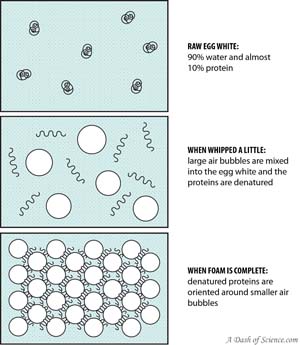Egg whites are unique. At first glance they are a bit gross. Raw egg whites are clear and slimy. When cooked, they are white and rubbery. Neither raw or cooked egg whites have appetizing descriptors. Egg whites do not even have a great flavor to compensate for their lack of physical appeal. But egg whites are amazing because they can be made into foam.
Physical Properties
Egg whites are about 90% water. The other 10% is primarily proteins, with a few vitamins, minerals and glucose mixed in. Biologically, egg whites provides water and food for the growing embryo.
Egg whites also protect the embryo from microorganisms. Some of the proteins within the egg white block digestive enzymes, others bind vitamins and minerals so that microbes can’t use them, at least one inhibits the reproduction of viruses, and another digests the cell walls of bacteria. It is no wonder eggs can last so long. They are well protected from microorganisms.
Making a Foam
For cooking purposes, these same proteins fulfill a completely different function. Egg whites are great for making foams. To make a foam, whip egg whites with a beater or wire whisk. The whipping action denatures (unfolds) the proteins and incorporates air into the whites. Denaturing the proteins exposes hydrophilic (water loving) and hydrophobic (water fearing) sections. The hydrophobic parts of proteins orient themselves around the incorporated air. This forms a protective lining around the air bubbles so they don’t pop. A foam gets stiffer the longer it is whipped, unless it is over-beaten. As time progresses, air bubbles are divided into smaller, more numerous bubbles. Depending on how long the egg whites are beaten, a foam can be classified as soft, firm, or stiff.
Effects of Other Ingredients
Fat interferes with foaming. So make sure the egg whites are completely separated from the egg yolk. It is also wise to use a non-plastic bowl. Fats tend to stick to plastic, even when washed well.
Sugar thickens the egg white mixture. This increases the time it takes to foam because the mix does not spread into thin walls around bubbles easily. But sugar does add stability to the foam. It makes for a less delicate foam and keeps water from draining out during heating. For these reasons sugar is often added after a foam has been created.
Salt increases the whipping time and decreases the stability of the foam. This is because salt dissolves into positive and negative ions. These ions bond with proteins, which disrupts the foam from forming. To protect the foam, salt is normally added after the whites have been beaten to the foamy stage.
Acids (vinegar, lemon juice, cream of tartar,etc) are also added after the foamy stage has been reached because they delay foam formation. Acids are useful because they stabilize the foam. Acids decrease the pH, which reduces the ability of the proteins to coagulate.
Basically…
Is this post as clear as mud? Technical terms aside, the take home message is: when making a meringue or other foam from egg whites, follow the recipe. There is a reason the instructions are so specific.
Have you ever tried to make a foam from egg whites? How did it go? I’d love to hear about your experience.
Photo: Jon Fletcher
Sources:
- Foods: A Scientific Approach by Helen Charley and Connie Weaver, 3 ed
- On Food and Cooking: The Science and Lore of the Kitchen by Harold McGee, 2004



I’ve never made a foam before, but I certainly want to try now!
LikeLike
I’ve never tried to make one, but now I know what pitfalls to avoid (which I probably would have fallen into because I often flub around with recipes…)
LikeLike
I have had terrible luck trying to get egg whites to foam for a meringue. My friend, Jytta, taught me to add cream of tartar to egg whites to stiffen them. I had much more success stiffening egg whites. But I’ve never understood how to time when egg whites have been overbeaten until it is too late. Whether I added cream of tartar or sugar, the foam mixture would just flop over and sag, then alot of condensation would be on the meringue after I took it out of the oven.
It was just like watching a balloon deflate and then have lots of raindrops collect on its surface. So sad when you want to make the perfect pie!
LikeLike
I am still working on perfecting meringues too. Maybe this video from Alton Brown will help.
LikeLike
Not mud-like at all! I am amazed at your ability to write about this stuff so that EVEN I, science-phobic that I am, can understand what you’re saying, find it interesting and digestible, and can read on rather than running away screaming. 🙂
LikeLike
I am very thankful for this, as I am currently doing a piece of work for my GCSE food and nutrition course in school and was worrying I wouldn’t be able to finish when I stumbled upon this website. This is very helpful and you have just saved me from having to pester a classmate! Thank you very much
LikeLike
(I forgot to say that the work is an evaluation on an egg foaming experiment where I have whipped egg whites with sugar, bicarb and yolk to see what happens)
LikeLike